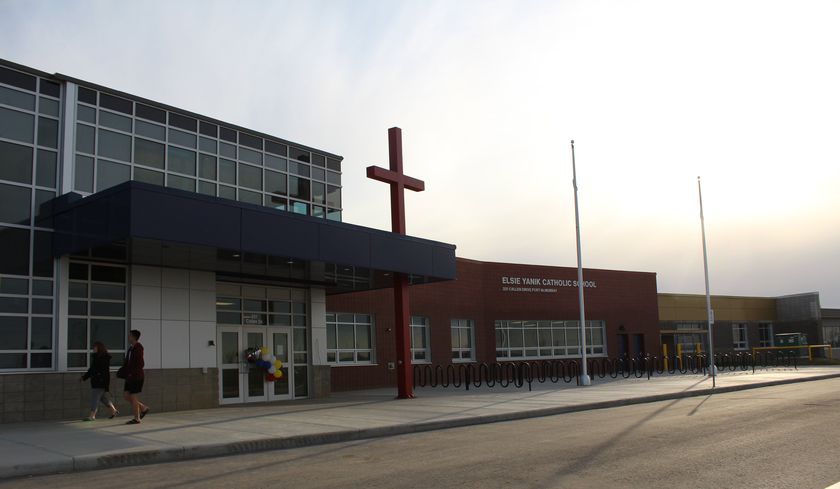Elsie Yanik Catholic School in Parsons Creek in Fort McMurray, Alta. on May 16, 2018. Laura Beamish/Fort McMurray Today/Postmedia Network
Alberta Health Services (AHS) has announced a COVID-19 outbreak at Sister Mary Phillips, making it the third school in Fort McMurray to have an outbreak.
The outbreak was announced Wednesday after two people tested positive for COVID-19.
On Thursday, FMCSD announced a third person had tested positive for COVID-19 at Holy Trinity High School, where an outbreak on Sept. 20.
On the same day, a second case was recorded at Elsie Yanik Catholic School, while St. Martha School identified its first case.
Contact tracing is still being conducted, but in all cases health officials say there is no evidence the cases come from in-school transmission.
AHS has allowed the schools to remain open.
In her Thursday update, Dr. Deena Hinshaw assured Albertans that schools remain safe for students.
Since schools started earlier this month, Hinsahw said Alberta has seen a week-over-week decrease in cases per week in school-aged children.
“I remind everyone that although two confirmed cases in a school may qualify as an outbreak, it is not a sign that a school is unsafe,” she said.
To date, there are 32 outbreaks in schools across the province and 163 active cases related to schools.
Hinshaw also addressed Wednesday’s report on opioid deaths in Alberta, which found opioids killed more Albertans between April and June than COVID-19 has since March.
Health officials blamed the social and economic fallout of lockdowns for the surge in deaths.
“The rise in deaths from opioid poisoning is reminder that the ripple effects of COVID-19 are large and that we need to continue seeking a balance in our response,” said Hinshaw.
“We must embrace two needs at once. The need in minimize the impact of COVID-19 and to minimize the impact that these restrictions have on the rest of our health.”
Provincial COVID-19 updates for September 24:
- A total of 17,190 people have been infected with the virus. The earliest known COVID-19 case in Alberta was detected in a blood sample collected on Feb. 24. The first case was announced on March 5.
- Of those cases, 15,467 people have recovered, or roughly 89.9 per cent of all cases.
- There were 158 new cases reported across Alberta in the last 24 hours.
- There are 1,462 active cases in Alberta.
- There are 58 cases hospitalized, with 14 people fighting the virus in intensive care units.
- There has been one new death related to COVID-19, bringing Alberta’s total to 261.
- 8,371 tests for COVID-19 were completed in the last 24 hours.
- To date, 1,255,039 tests for COVID-19 have been carried out on 958,534 people.
COVID-19 in Fort McMurray:
- There were six new recoveries in Fort McMurray in the past 24 hours, bringing the total recoveries to 194 since the first case was reported in the city on March 19.
- There were nine new active cases in Fort McMurray in the past 24 hours, bringing the known total to 48.
- There has been one death related to COVID-19 in Fort McMurray reported since Sept. 8.
COVID-19 in rural areas:
- No new COVID-19 cases were recorded in Wood Buffalo’s rural areas in the past 24 hours, keeping the total active cases at four.
- There were no new recoveries in Wood Buffalo’s rural areas in the past 24 hours, keeping the total at 61 recoveries.
- AHS has not confirmed which rural communities had active COVID-19 cases, only community leaders have.
- Fort McKay’s First Nation and Métis leaders have made it mandatory to wear masks in the community.
- There have been no deaths related to COVID-19 in the RMWB’s rural areas.
Local COVID-19 outbreaks:
- Information on school outbreaks can be found online from Alberta Health Services. No school in Wood Buffalo has been ordered to close.
- Information on workplace outbreaks can be found online from Alberta Health Services.
- An outbreak at Canadian Natural’s Albian site was declared after five workers tested positive for the virus on Aug. 13.
- A precautionary outbreak was declared at the Northern Lights Regional Health Centre’s Medical unit when a patient tested positive on Aug. 21.
- An outbreak at the Syncrude sites north of Fort McMurray was declared on Sept. 3 when 11 workers tested positive for the virus. As of Sept. 14, 15 workers have COVID-19 while 13 have recovered.
- An outbreak at Suncor’s base plant was declared on Sept. 4 after five workers tested positive for the virus.
- An outbreak at Earls Kitchen and Bar on Morrison Street was declared on Sept. 14. As of Sept. 23, all staff have recovered. The restaurant has been allowed to remain open.
- An outbreak at Holy Trinity High School and St. Gabriel’s School was declared on Sept. 20. At both schools, at least two people tested positive for the virus.
- An outbreak was declared at Sister Mary Phillips School on Sept. 23. There have been two positive cases for COVID-19 reported in relation to the school.
- St. Martha School reported its first COVID-19 case on Sept. 24.
- Two positive cases at Elsie Yanik Catholic School were reported on Sept. 24.
- An outbreak is declared when five people at a public site, such as a workplace, test positive for COVID-19. At continuing care centres, the number is two. However, AHS chose to declare a precautionary outbreak when one person tested positive for the virus at the Northern Lights Regional Health Centre.
- An outbreak is over when no new COVID-19 cases have been reported after 30 days.
